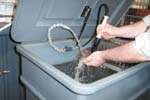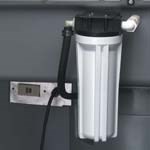Breaking Down, Cleaning Up
Bioremediation is a process we live with every day. More specifically, bioremediation is a natural process in which certain strains of microbes have been identified for their ability to break down or digest contaminants that we do not want in our environment, such as oil, petrochemicals and other compounds.
When a supertanker loaded with Alaskan crude ran aground in 1989, millions of gallons of oil washed up on the beaches of Prince William Sound. We saw TV news pictures of many workers cleaning up the shore with rags, buckets and shovels in an effort to undo the environmental damage. But what we didn't see were scenes of microscopic organisms at work in the water and on shore busily converting the contaminants to carbon dioxide and water and cleaning up the rest of that infamous mess.
The process of putting microbes to work in breaking down and cleaning up hazardous and unwanted chemicals has been evaluated for years. The Exxon Valdez oil spill put bioremediation on the map in a big way as a means of cleaning up industrial hazardous waste. Today, advanced, specially developed versions of microbes are working daily in industrial processes such as parts cleaning.
Featured Content
How can the parts cleaning process be changed in ways that help control the hazards and costs? Let's take a look again at the Exxon Valdez.
A Simple, Natural Process
Bioremediation is a process we live with every day. More specifically, bioremediation is a natural process in which certain strains of microbes have been identified for their ability to break down or digest contaminants that we do not want in our environment, such as oil, petrochemicals and other compounds. Their digestive processes leave behind less complex and inert (stable) molecules that are not toxic or hazardous, along with water, carbon dioxide, methane and hydrogen.
As an example, one-celled or microscopic plants and animals, bacteria, fungi and protozoa are at work in septic tanks, sludge ponds and even dead trees. Through their metabolic processes (converting sludge and trees, for example, into more microbes and energy), they break waste down into simpler, more basic molecular structures.
The process of bioremediation was first recognized for its potential cleanup value in the 1960s, when biologists started to take a serious look at microbes as a way to help clean up unwanted human-made materials. They discovered some species discharged enzymes that are particularly good at breaking down hydrocarbon compounds. But in their natural surroundings, these microbes work very slowly when it comes to cleaning up large, concentrated quantities of contaminants, such as those from an oil spill.
Then researchers in the 1970s and '80s found a particular species of microbes that is very good at breaking down specific compounds. They also found that by helping the microbes along—by supplying enzymes and catalysts to speed up their reproduction—the process could be accelerated to a point where it was more economic and "natural" for hazardous waste cleanup. As a result, bioremediation came out of the lab and into the real world in places such as Prince William Sound.
An Industrial Application
In parts cleaning, aqueous or water-based cleaners are often used. But their leftovers—sludge and other contaminants filtered from aqueous cleaning agents—can result in high disposal costs. Bioremediation can "naturally" take care of a number of safety, cost and environmental concerns.
For example, one cleaning system takes advantage of a blend of bacterial cultures that have been adapted to degrade wastes from the parts washing process. The microbes are incorporated into the cleaning solution, a neutral mixture (pH 7.0) of emulsifiers and surfactants that contains no volatile organic compounds, phosphates, formaldehyde or biocides.
The bioremediation process used in this system eliminates a wide range of organic compounds from the parts washing solution: crude oil, most oils, many solvents, greases, amines, creosotes, phenols, fats, ethylene glycol, some chlorinated hydrocarbons, and other complex organic compounds.
Rather than dissolving grease and oils, such as petrochemical solvents or mineral spirits, the parts cleaning solution works to break down the surface tension of the grease and oils on the parts. Dissolved contaminants flow through a filter that traps large solid particles.
The active microbes and enzymes then go to work to metabolize and break down the contaminants in the fluid reservoir into water and carbon dioxide, leaving the user with clean solution. Waste disposal is reduced by around 90 percent.
A Safe, Economical Solution
Applying the bioremediation process to a core industrial task such as parts cleaning has proven to be effective, safe and economical.
The economic and operational benefits of bioremediation in parts cleaning are numerous. Handling and storage problems are eliminated. Employee and environmental exposure is at an absolute minimum. And training, record keeping and documentation, and disposal costs are either unnecessary or minimal.








